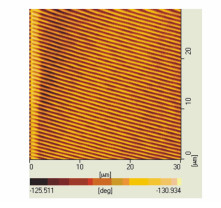-
摘要: 采用DFB分布反馈结构的有机激光由于其自身优点备受关注,而利用高阶布拉格反馈的多光束有机激光及其原理鲜有报道。不同于以往的低阶布拉格反馈形成单波导或单光束激光,本文通过在平面有机半导体波导引入高阶布拉格反馈分别制备了红色和蓝色多束有机激光器。利用四阶布拉格反馈和PVK:DCJTI薄膜实现三光束红光激光器,出射角度为±53°和0.5°。利用五阶布拉格反馈和PS:DSA-ph薄膜实现四光束蓝光激光器,出射角度为±18°和±75°。融合平面波导与光栅耦合的机理,研究了高阶布拉格光栅反馈与器件特性之间的关系。结果表明,理论计算的光束耦合角度和实际测试相符,结果在一定程度上为多光束有机激光器件的设计提供了参考。Abstract: The advantages of organic lasers with DFB distributed feedback structures have attracted much attention, however, there are few reports on the principle of multi-beam organic lasers using high-order Bragg feedback. Different from single-waveguide or single-beam lasers implemented by low-order Bragg feedback in the past, high-order Bragg feedback is introduced into a planar organic semiconductor waveguide to produce red and blue multi-beam organic lasers in this paper. Using a fourth-order Bragg feedback and PVK:DCJTI film, a three-beam red laser is realized with an exit angle of ±53° and 0.5°. A four-beam blue laser is implemented using a fifth-order Bragg feedback and PS:DSA-ph film with exit angles of ±18° and ±75°. The relationship between higher-order Bragg grating feedback and device characteristics is studied by combination of plane waveguide and grating coupling. The results show that the theoretically calculated beam coupling angle is consistent with the actual test, which provides guidance for the design of multi-beam organic laser devices to some extent.
-
Key words:
- organic laser /
- Bragg scattering /
- grating coupling
-
Figure 5. Graphical determination of the possible oscillation wavelengths for the DFB laser(PVK:DCJTI) in a multimode optical waveguide.Curves show the effective refractive index of the various TE and TM waveguide modes as a function of wavelength.The shaded region shows the approximate wavelength range over which the DCJTI exhibits gain.Intersection of the straight line with the dispersion curves describes the possible oscillation wavelengths
-
[1] FROLOV S V, VARDENY Z V, YOSHINO K. Cooperative and stimulated emission in poly(p-phenylene-vinylene) thin films and solutions[J]. Phys. Rev. B, 1988, 57:9141. http://www.osti.gov/scitech/biblio/627813 [2] HIDE F, DIAZ-GARCIA M A, SCHWARTZ B J, et al.. Semiconducting polymers:a new class of solid-state laser materials[J]. Science, 1996, 273:1833. doi: 10.1126/science.273.5283.1833 [3] 刘启坤, 孔金霞, 朱凌妮, 等.电致发光用于大功率半导体激光器失效模式分析[J].发光学报, 2018, 39(2):180-187. http://www.opticsjournal.net/Articles/abstract?aid=OJ180314000103Xu1w4zLIU Q K, KONG J X, ZHU L N, et al.. Failure mode analysis of high-power laser diodes by electroluminescence[J]. Chinese Journal of Luminescence, 2018, 39(2):180-187.(in Chinese) http://www.opticsjournal.net/Articles/abstract?aid=OJ180314000103Xu1w4z [4] 陈运达, 汪之国, 江奇渊, 等.非理想1/4波片对泵浦光偏振态的影响[J].中国光学, 2017, 10(2):226-233. http://www.chineseoptics.net.cn/CN/abstract/abstract9475.shtmlCHEN Y D, WANG ZH G, JIANG Q Y, et al.. Influence of nonideal 1/4 wave plate on pump light polarization[J]. Chinese Optics, 2017, 10(2):226-233.(in Chinese) http://www.chineseoptics.net.cn/CN/abstract/abstract9475.shtml [5] 公爽, 田金荣, 李克轩, 等.新型二维材料在固体激光器中的应用研究进展[J].中国光学, 2018, 11(1):18-30. http://www.chineseoptics.net.cn/CN/abstract/abstract9547.shtmlGONG SH, TIAN J R, LI K X, et al.. Advances in new two-dimensional materials and its application in solid-state lasers[J]. Chinese Optics, 2018, 11(1):18-30.(in Chinese) http://www.chineseoptics.net.cn/CN/abstract/abstract9547.shtml [6] FOZLOV V G K, BULOVIC V, BURROWS P E, et al.. Laser action in organic semiconductor waveguide and doubleheterostructure devices[J]. Nature, 1997, 389:362. doi: 10.1038/38693 [7] TESSLER N, DENTON G J, FRIEND H, et al.. Lasing from conjugated-polymer microcavities[J]. Nature, 1996, 382:695. doi: 10.1038/382695a0 [8] TURNBULL G A, ANDREW P, JORY M J, et al.. Relationship between photonic band structure and emission characteristics of a polymer distributed feedback laser[J]. Phys. Rev. B, 2001, 64:125122. doi: 10.1103/PhysRevB.64.125122 [9] HOLZER W, PENZKOFER A, PERTSCH T, et al.. Corrugated neat thin-film conjugated polymer distributed-feedback lasers[J]. Appl. Phys. B:Lasers Opt., 2002, 74:333. doi: 10.1007/s003400200821 [10] KARNUTSCH C, GYRTNER C, HAUG V, et al.. Low threshold blue conjugated polymer lasers with first-and second-order distributed feedback[J]. Appl. Phys. Lett., 2006, 89:201108. doi: 10.1063/1.2390644 [11] HELIOTIS G, CHOULIS S A, ITSKOS G, et al.. Low-threshold lasers based on a high-mobility semiconducting polymer[J]. Appl. Phys. Lett., 2006, 88:081104. doi: 10.1063/1.2178197 [12] LIU M H, LIU Y G, ZHANG G Y, et al.. Organic holographic polymer dispersed liquid crystal distributed feedback laser from different diffraction orders[J]. J. Phys. D Appl. Phys., 2016, 49:465102. doi: 10.1088/0022-3727/49/46/465102 [13] KALLINGER CH, HILMER M, HAUGENEDER A, et al.. A flexible conjugated polymer laser[J]. Adv. Mater., 1998, 10:920. doi: 10.1002/(ISSN)1521-4095 [14] SHERIDAN A K, TURNBULL G A, SAFONOV A N, et al.. Tuneability of amplified spontaneous emission through control of the waveguide-mode structure[J]. Phys. Rev. B, 2000, 62:11930. https://vdocuments.mx/documents/tuneability-of-amplified-spontaneous-emission-through-control-of-the-waveguide-mode.html [15] JEON S, JEON Y M, KIM J W, et al.. A blue organic emitting diode derived from new styrylamine type dopant materials[J]. Synthetic Metals, 2007, 157(13-15):558-563. doi: 10.1016/j.synthmet.2007.06.005 -






 下载:
下载:








